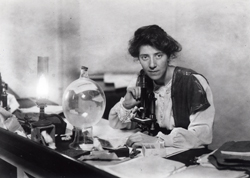Geologist and science writer Nina Morgan hears of a formidable force in palaeobotany
Morgan, N. Distant Thunder: Get the picture?
Geoscientist 29 (9), 26, 2019
https://doi.org/10.1144/geosci2019-052;
Download the pdf here
Passionate about palaeobotany, and a pioneer in the study of coal geology, Marie Stopes [1880-1958] is best known to the public at large as a sex symbol for her enthusiastic promotion of birth control and best-selling books such as
Married Love, first published in 1918. Blessed with a formidable intellect, as well as a flamboyant and determined nature, she was nothing if not controversial.
 Left, Marie Stopes (taken in 1904) [Author unknown; Public domain]
Left, Marie Stopes (taken in 1904) [Author unknown; Public domain]
In 1902, at a time when few women attended universities, Stopes obtained a double honours degree in botany and geology from University College London (UCL)—after just two years of study. She went on to become the first woman to obtain a PhD in botany from the Botanical Institute in Munich, where university rules had to be altered to allow her to graduate. In 1904, she was appointed Demonstrator in Palaeobotany at Manchester University, overcoming opposition from some in the Senate who opposed the idea of a young woman teaching men. In 1905, she became the youngest Doctor of Science in Britain, and in 1907 she travelled to Japan to spend two years carrying out palaeobotanical research. Along the way she prepared museum catalogues, participated in international discussions, went down coal mines and carried out pioneering work on Carboniferous calcite-rich concretions known as coal-balls.
Strong minded
In 1910, Stopes was elected a fellow of UCL and, for the rest of her life, made regular appearances in the geology department. As a young Assistant Lecturer at UCL during the 1950s, Eric Robinson [born 1929] recalls how he was delegated to receive her when she visited the department because the then professor, Sydney Hollingworth [1899-1966], chose not to meet her. "It was the forceful aspects of her personality and her strongly held views that were the problem", he explains. "She was an old lady by then, but very active. She used to come into the department, bringing copies of her publications. She had a running campaign with the press, and she didn't suffer fools lightly. Her life was marked by an uncompromising drive, and bruising personal contacts with people who were in the same fields of research, including superiors who often seem to have conceded for their own peace of mind and life."
Vanity fair?
In later life, Stopes also exhibited a streak of vanity. "She was a lady with a rather strong profile", Robinson remembers, "and when she was quite old, she had her portrait painted. It was designed to present her best face. I went off with Professor Hollingworth to look at the result, and we were joined by a professor at the Slade School of Fine Art at UCL. He judged the painting to be 'a bit thin'. His suggestion was to save the expense of getting it repainted, and just paint something else on top of the canvas.
Stopes, it turned out, had other ideas. Years later, when Robinson went into the main common room at UCL, he was surprised to find that "there was this portrait. Marie had had it repainted. Then I found out she had had five copies made and given to various institutions, including the University of Manchester and the Asiatic Society."
The portrait in question is probably the one Stopes commissioned from Sir Gerald Kelly [1879-1972] in 1953—just five years before her death—which depicts her against a black background wearing the flowing crimson and cream UCL academic robes. Kelly himself pronounced the portrait “strikingly like her”, and it is now on display at the National Portrait Gallery in London. Stopes was apparently a great admirer of Kelly's work, which included portraits of Elizabeth, the Queen Mother, and King George VI among others. The feeling seems to have been mutual. Kelly described Stopes as the "most remarkable woman, whose fame will outlive so many". If Robinson's account is to be believed—that's certainly one way of putting it!
End notes:
Sources for this vignette include Marie Stopes: passionate about palaeobotany by Hugh Falcon-Lang,
Geology Today,
24/4, pp. 132-136; Back to the past by Eric Robinson,
Geology Today, 24/6, p, 208; the 2004 DNB entry for Marie Stopes by Lesley A. Hall; and an interview with Eric Robinson recorded in July 2019. The portrait can be viewed at
https://www.npg.org.uk/collections/search/portrait/mw06069/Marie-Stopes
Nina Morgan is a geologist and science writer based near Oxford. Her latest book, The Geology of Oxford Gravestones, is available via www.gravestonegeology.uk